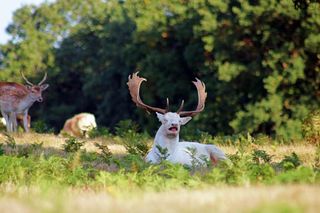Photographer Captures Rare, White Deer Mid-Sneeze (Because Nature Is Majestic)

On Sept. 26, hobbyist nature photographer Oban van Shie was strolling through Bradgate park — an 800-year-old deer park in Leicestershire, England — when he was captivated by a strange sight. Sitting among the park's resident herds of red and fallow deer, a snow-white buck rested its body in the tall, green grass.
"I had never seen a white deer before," van Shie told Live Science in an email. "I was intrigued given their rarity, although many others that have visited the park will have no doubt seen it."
Van Shie readied his camera and started snapping the buck from afar. It wasn't until he got home that he realized the true treasure he'd recovered. The glorious deer — eyes clenched, mouth cracked, tongue lolling — had been photographed mid-sneeze.
The next day, van Shie posted the buck pic on Reddit's "mildly interesting" forum, where it received nearly 90,000 upvotes. While most commenters were impressed or eager to draw comparisons to the TV show "BoJack Horseman," some questioned van Shie's interpretation of the photo.
"I have received some comments doubting whether the deer was sneezing but I was far away enough from the deer that it wouldn’t feel threatened, especially considering that the park is open to the public and there wasn’t enough noise for it to have been calling out," van Shie said. "Having done some research I am confident that it was in fact a sneeze."
1-in-a-million… or 8 million
So, how rare is this photo, really? It's hard to say for sure, but Live Science is going to bet its doe on "pretty bucking rare." (Sorry… they say puns are a workout for your brain.)
For starters, all-white deer — or "leucistic" deer — are the rarest of the four color-varieties of fallow deer. Unlike albinism, a condition that results from the absence of the pigment melanin, leucism is a recessive-gene condition that results from the loss of multiple types of pigment. While we can't say exactly how common the condition is in fallow deer, nature.org previously reported that leucism effects about 1 percent of white-tail deer worldwide.
Sign up for the Live Science daily newsletter now
Get the world’s most fascinating discoveries delivered straight to your inbox.
And as for the sneezing? Not much research has been done on deer-sneeze frequency… or even human-sneeze frequency, for that matter. However, one small, snotty 2006 study found that a control group of nonallergic people sneezed an average of 1.1 times per person per day.
If we hypothesize that the average sneeze takes about 1 second from start to finish, and that fallow deer sneeze exactly as often as the human-control group in that 2006 study, then the odds van Shie photographed a single deer at the precise moment of its daily sneeze are about 1 in 80,000. If there is a 1 percent chance that that sneezing deer is a leucistic deer, the odds of taking this photograph drop to about 1 in 8,000,000. (Live Science does not endorse doing math or science in this way.)
In conclusion, van Shie's photo is probably a lot rarer than seeing a humpback whale sneeze a rainbow, but less rare than meeting an astronaut who just sneezed all over his or her space helmet. Regardless — congratulations to Oban for taking a remarkable photograph that, for one glorious moment, made the internet sigh a collective "aww… choo!"
Originally published on Live Science.

Brandon is the space/physics editor at Live Science. His writing has appeared in The Washington Post, Reader's Digest, CBS.com, the Richard Dawkins Foundation website and other outlets. He holds a bachelor's degree in creative writing from the University of Arizona, with minors in journalism and media arts. He enjoys writing most about space, geoscience and the mysteries of the universe.
